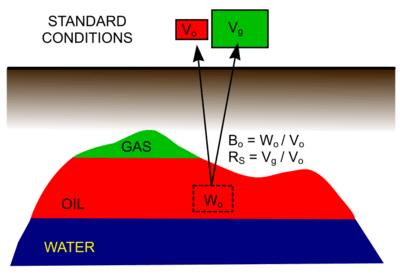Gas oil ratio
When oil is brought to surface conditions it is usual for some natural gas to come out of solution. The gas/oil ratio (GOR) is the ratio of the volume of gas that comes out of solution, to the volume of oil at standard conditions.

In reservoir simulation gas oil ratio is usually abbreviated .
A point to check is whether the volume of oil is measured before or after the gas comes out of solution, since the oil volume will decrease after the gas comes out.
In fact gas dissolution and oil volume shrinkage will happen at many stages during the path of the hydrocarbon stream from reservoir through the wellbore and processing plant to export. For light oils and rich gas condensates the ultimate GOR of export streams is strongly influenced by the efficiency with which the processing plant strips liquids from the gas phase. Reported GORs may be calculated from export volumes which may not be at standard conditions.
The GOR is a dimensionless ratio (volume per volume) in metric units, but in field units, it is usually measured in cubic feet of gas per barrel of oil or condensate.
In the states of Texas and Pennsylvania, the statutory definition of a gas well is one where the GOR is greater than 100,000 ft3/bbl or 100 Kcf/bbl. The state of New Mexico also designates a gas well as having over 100 MCFG per barrel (http://www.nmcpr.state.nm.us/nmac/parts/title19/19.015.0002.htm)
The Oklahoma Geologic Survey recently published Map of Oklahoma Oil and Gas Fields distinguished by Oil and Gas Ratio this map that defines a gas well as having greater than 20 MCFG per barrel of oil. They go on to define an oil well as having a GOR of less than 5 MCFG/BBL and an oil and gas well between 5 and 20 MCFG/BBl.
In the newly proposed Information Collection Request for Oil and Gas Facilities (EPA ICR No. 2548.01, OMB Control No. 2060-NEW) the EPA has divided well types into five categories as such: 1. Heavy Oil (GOR ≤ 300 scf/bbl) 2. Light Oil (GOR 300 < GOR ≤ 100,000 scf/bbl) 3. Wet Gas (100,000 < GOR ≤1,000,000 scf/bbl) 4. Dry Gas (GOR > 1,000,000 scf/bbl) 5. Coal Bed Methane.
In two-stroke engines
As two-stroke engines use their crankcase to pressurize the air:fuel mixture before transfer to the cylinder, any standard lubricating oil left there (per practice with four-stroke engines) would be swept up and burnt with the fuel. To provide cylinder lubrication, fuels supplied to two-stroke engines are often mixed with oil so that it can coat the cylinders and bearing surfaces along its path. The ratio of gas to oil is set by the engine manufacturer but ranges from 30:1 to 50:1 per volume unit. Oil remaining in the mixture is burnt with the fuel and results in a familiar blue smoke and odor.
See also
- stranded gas